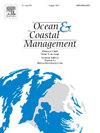Delta-scale mapping of coastal erosion vulnerability at the modern Yellow River Delta and implications for geomorphic sustainability
IF 5.4
2区 环境科学与生态学
Q1 OCEANOGRAPHY
引用次数: 0
Abstract
River deltas are highly vulnerable coastal areas, particularly susceptible to human interference and environmental changes. Due to reduced sediment supply and strong coastal dynamics, deltaic coasts are struggling to maintain shoreline progradation, necessitating urgent needs for integrated and data-enriched vulnerability assessments to address erosion risks. However, previous studies have often been constrained by observational datasets and lacked a systematic analysis of erosion vulnerability in deltaic coasts during varying periods under combined human activities and climatic changes. The modern Yellow River Delta (YRD) serves as a typical river-dominated delta system, currently undergoing geomorphic transition and facing erosion risks due to changing environmental conditions. This study integrates methods of numerical modeling, Analytic Hierarchy Process (AHP), and Coastal Vulnerability Index (CVI) to develop a comprehensive framework for assessing coastal erosion vulnerability. We then apply this framework to evaluate the erosion vulnerability of different coastal segments of the YRD, using multi-year hydro-geomorphic and human-interfered indicators. The results reveal that the overall erosion vulnerability of the YRD has decreased during 1992–2015, characterized by pronounced spatial and temporal disparities. The abandoned northern YRD exhibits high erosion vulnerability, primarily due to the absence of fluvial sediment supply, strong coastal currents, and the additional impact of wave climate. In contrast, the artificially protected coasts and western Laizhou Bay show relatively lower vulnerability marked by coastal protection measures and weak hydrodynamic influences. The segment of Qingshuigou delta lobe shows high vulnerability in sediment-starved areas, attributable to both engineered diversions and natural channel migration. Future management strategies should integrate coastal protection measures with wetland restoration efforts, as well as optimize riverine water and sediment regulation within the river basin and deltaic channels to enhance riverine sediment delivery to severe erosion zones.
现代黄河三角洲海岸侵蚀脆弱性的三角洲尺度制图及其对地貌可持续性的影响
河流三角洲是非常脆弱的沿海地区,特别容易受到人为干扰和环境变化的影响。由于沉积物供应减少和强烈的沿海动态,三角洲海岸正在努力维持海岸线的退化,迫切需要综合和数据丰富的脆弱性评估来应对侵蚀风险。然而,以往的研究往往受到观测数据的限制,缺乏对人类活动和气候变化共同作用下不同时期三角洲海岸侵蚀脆弱性的系统分析。现代黄河三角洲是典型的以河流为主导的三角洲体系,目前正处于地貌转型阶段,面临着环境变化带来的侵蚀风险。本研究将数值模拟、层次分析法(AHP)和海岸脆弱性指数(CVI)相结合,建立了海岸侵蚀脆弱性综合评估框架。然后,我们使用多年水文地貌和人为干扰指标,将该框架应用于长三角不同海岸段的侵蚀脆弱性评估。结果表明:1992—2015年,长三角侵蚀脆弱性总体呈下降趋势,且存在明显的时空差异。废弃的长三角北部地区表现出高度的侵蚀脆弱性,这主要是由于缺乏河流沉积物供应、强烈的海岸流以及波浪气候的额外影响。人工保护海岸和莱州湾西部的脆弱性相对较低,海岸防护措施较多,水动力影响较弱。清水沟三角洲叶段在缺沙区表现出高度的脆弱性,这主要是由于工程改道和自然河道迁移的双重作用。未来的管理策略应将海岸保护措施与湿地恢复工作结合起来,并优化流域和三角洲河道内的河流水沙调节,以加强河流向严重侵蚀带的输沙量。
本文章由计算机程序翻译,如有差异,请以英文原文为准。
求助全文
约1分钟内获得全文
求助全文
来源期刊

Ocean & Coastal Management
环境科学-海洋学
CiteScore
8.50
自引率
15.20%
发文量
321
审稿时长
60 days
期刊介绍:
Ocean & Coastal Management is the leading international journal dedicated to the study of all aspects of ocean and coastal management from the global to local levels.
We publish rigorously peer-reviewed manuscripts from all disciplines, and inter-/trans-disciplinary and co-designed research, but all submissions must make clear the relevance to management and/or governance issues relevant to the sustainable development and conservation of oceans and coasts.
Comparative studies (from sub-national to trans-national cases, and other management / policy arenas) are encouraged, as are studies that critically assess current management practices and governance approaches. Submissions involving robust analysis, development of theory, and improvement of management practice are especially welcome.
 求助内容:
求助内容: 应助结果提醒方式:
应助结果提醒方式:


